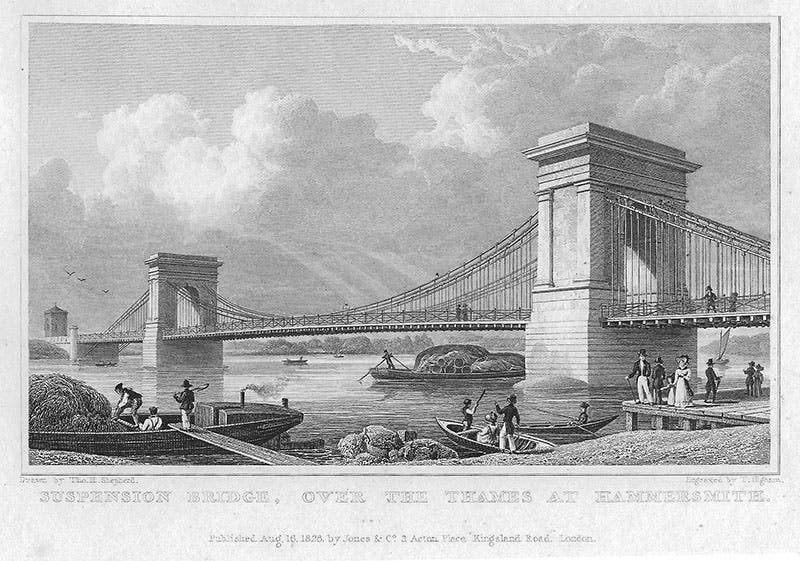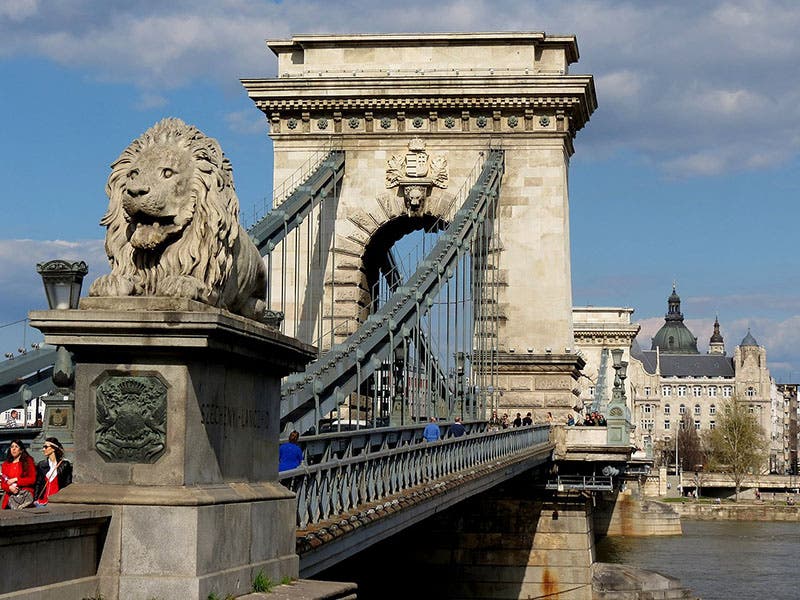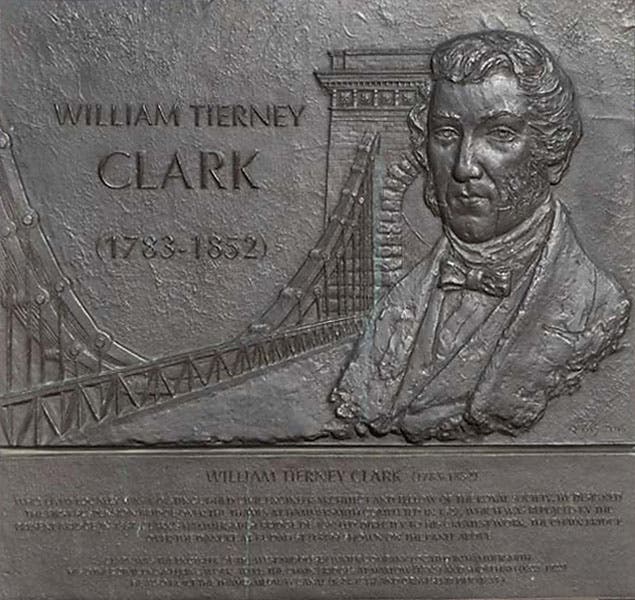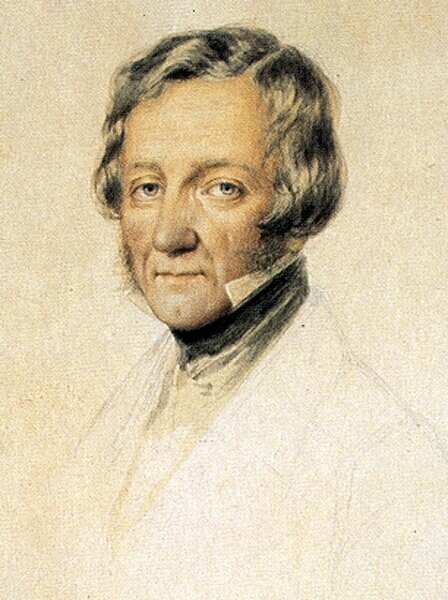Scientist of the Day - William Tierney Clark
William Tierney Clark, a British civil engineer, was born Aug. 23, 1783. Not much is known about his early life, except that he was interested early on in building things, and that he had encouragement from none other than John Rennie and Thomas Telford, both distinguished engineers, so Clark must have shown promise early on. Clark, like Telford, began to specialize in bridges, designing the Hammersmith Bridge that crosses the Thames in London, the first suspension bridge to do so. Completed in 1827, it served well until one of its piers was struck by a boat; the bridge was replaced by the current bridge, on the original piers, in 1887, and so we remember it with an engraving (second image, below).
Clark followed that with another suspension bridge, this one in Marlow, about 33 miles upstream of London. The Marlow Bridge, completed in 1832, is still in place (third iimage, below). Clark did not know it at the time, but the Marlow Bridge turned out to be a practice exercise for a much larger bridge, to be built over the River Danube in far-away Hungary. The Hungarian statesman István Széchenyi wanted a bridge to unite the two cities of Buda and Pest, on opposite sides of the Danube. He sent a delegation to England to check out the new English bridges, and they must have liked the Hammersmith and the Marlow bridges, for they reached out to Clark in 1832 and sent him a list of queries as to what kind of bridge he would build over the Danube, where he would get materials, what the cost might be, etc. The questioners (who included Széchenyi) were very concerned about the winter ice, and wondered whether any permanent bridge could stand up to it. Clark answered the questions as best he could, given that he had never even seen the site, and he confidently declared that a well-built bridge could easily withstand whatever ice Nature threw at it. We know the questions, and Clark’s answers, because Clark printed them all in the book he would later write.
Clark had a design ready by 1839, and an on-site engineer to oversee the construction, named Adam Clark (not related). The bridge would be a larger version of the Marlow Bridge, with two tall piers in the river and two anchor piers on each end. From the central piers, two massive chains of flat wrought-iron links would be suspended, from which the roadbed would be hung. At least five years were spent in digging cofferdams, so that the support for the masonry piers could be excavated to bedrock, and then the piers were gradually built up by stone masons. Clark came over at least once a year, in the summers, to find sources for granite, limestone, and wrought and cast iron. Many of the laborers and much of the material had to be brought in from England, although Clark was pleasantly surprised by the quality of some of the Hungarian iron.
The bridge was ready for the suspension chains by 1848, when suddenly Buda and Pest were wracked by revolution, as Hungary attempted, unsuccessfully, to cast off the yoke of the Austrian Empire. Fortunately, the bridge escaped damage in the battles that swirled through both cities. The chains were then raised, the roadway hung, and the bridge opened on Nov. 20, 1849. For two cities that had previously been connected only by boat-bridges, removed in the winter, it was a true game-changer, marking the birth of the modern city of Budapest. The bridge has been a national symbol ever since, and both Clarks became adopted heroes. The bridge was later officially named the Széchenyi Chain Bridge, but to most, it is just the Chain Bridge.
Clark published a book on the Chain Bridge of Budapest, called An Account, with Illustrations, of the Suspension Bridge across the river Danube, uniting Pesth with Buda and the Adjacent Country, in the Kingdom of Hungary (1852-53). Our catalog says that we have a copy, but a sorry copy it is, brittle and browned and missing the first 11 plates. It came to us from the Engineering Societies Library in New York in 1995, and someone must have left it on a window ledge and forgotten about it until the sun had done its dirty work. I considered scanning some of the plates, but the paper is so brittle that I thought better of it. The plates are all diagrams anyway, so we are not missing any really stunning images by omitting the book. But we do need to find another copy.
The photographs we show of the modern bridge, which do capture the essence of Clark’s achievement, are a little misleading (first and fourth images). The iron chains were replaced in the early 20th century, and then in 1945, the retreating German army destroyed the bridge, except for the piers (Clark was right – they were indestructible). The bridge was rebuilt after the war, following Clark’s plans but to modern standards, and it was opened again on Nov. 20, 1949, on the centennial of the original opening.
A plague commemorating Clark is mounted on the Chain Bridge in Budapest, but I could not find a good copyright-free photo of it, so I show instead a copy of the Budapest plaque, placed alongside the Thames in London, in sight of the modern Hammersmith Bridge (fifth image, above).
There is an excellent oil portrait of Clark somewhere in Budapest, which is usually used to illustrate short biographies of Clark, but I ran across a watercolor in the Budapest History Museum that I find appealing, and I show it here instead (sixth image, above).
Dr. William B. Ashworth, Jr., Consultant for the History of Science, Linda Hall Library and Associate Professor emeritus, Department of History, University of Missouri-Kansas City. Comments or corrections are welcome; please direct to ashworthw@umkc.edu.











